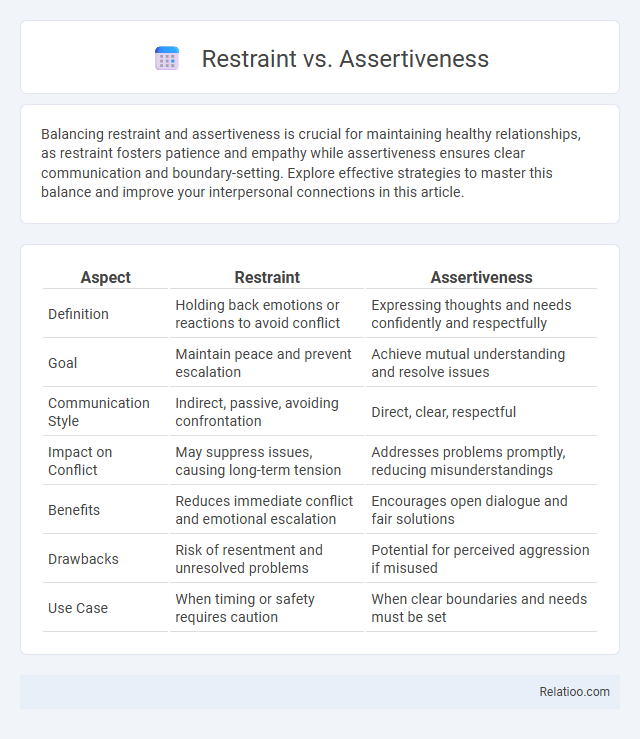Balancing restraint and assertiveness is crucial for maintaining healthy relationships, as restraint fosters patience and empathy while assertiveness ensures clear communication and boundary-setting. Explore effective strategies to master this balance and improve your interpersonal connections in this article.
Table of Comparison
| Aspect | Restraint | Assertiveness |
|---|---|---|
| Definition | Holding back emotions or reactions to avoid conflict | Expressing thoughts and needs confidently and respectfully |
| Goal | Maintain peace and prevent escalation | Achieve mutual understanding and resolve issues |
| Communication Style | Indirect, passive, avoiding confrontation | Direct, clear, respectful |
| Impact on Conflict | May suppress issues, causing long-term tension | Addresses problems promptly, reducing misunderstandings |
| Benefits | Reduces immediate conflict and emotional escalation | Encourages open dialogue and fair solutions |
| Drawbacks | Risk of resentment and unresolved problems | Potential for perceived aggression if misused |
| Use Case | When timing or safety requires caution | When clear boundaries and needs must be set |
Understanding Restraint and Assertiveness
Understanding restraint involves recognizing your ability to control impulses and maintain patience in challenging situations, which promotes thoughtful decision-making and emotional regulation. Assertiveness requires confidently expressing your thoughts and needs without aggression, ensuring your voice is heard while respecting others. Your balanced approach to restraint and assertiveness enhances effective communication and fosters healthier relationships in both personal and professional environments.
Defining Key Differences
Restraint involves exercising self-control and limiting one's actions or emotions, while assertiveness is characterized by confidently expressing thoughts, needs, or rights without aggression. The key difference lies in restraint emphasizing suppression or moderation of impulses, whereas assertiveness promotes clear, direct communication and standing up for oneself. Understanding these distinctions aids in applying appropriate behavioral strategies in personal and professional interactions.
Psychological Foundations
Restraint, assertiveness, and aggression represent distinct behavioral responses rooted in psychological foundations related to self-regulation, communication, and emotional control. Psychological theories highlight restraint as the ability to inhibit impulses and delay gratification, often linked to executive functions and the prefrontal cortex. Assertiveness is characterized by confident, clear communication of one's needs and rights without violating others, supported by social cognitive skills and healthy self-esteem, whereas aggression involves hostile or forceful behavior often driven by emotional dysregulation and amygdala activation.
Benefits of Practicing Restraint
Practicing restraint enhances emotional intelligence by allowing you to pause before reacting, which reduces impulsive decisions and prevents unnecessary conflicts. This self-control fosters better communication and stronger relationships, as it demonstrates respect and understanding towards others' perspectives. Embracing restraint promotes mental clarity and resilience, helping you navigate stressful situations with calmness and wisdom.
Advantages of Assertiveness
Assertiveness offers the advantage of clear and confident communication that respects both your rights and those of others, fostering mutual understanding and reducing conflicts. Unlike restraint, which may suppress your needs, assertiveness empowers you to express your thoughts and feelings honestly while maintaining respect. This balance improves personal relationships and professional interactions, enhancing overall emotional well-being and decision-making.
Restraint vs Assertiveness in Communication
Restraint in communication involves carefully controlling one's expressions to avoid conflict and maintain harmony, often prioritizing listening and thoughtful responses. Assertiveness emphasizes clear, confident expression of thoughts and needs while respecting others, enhancing mutual understanding and problem-solving. Balancing restraint and assertiveness enables effective communication by managing emotional regulation without suppressing authentic self-expression.
When to Choose Restraint
Choosing restraint is essential when managing conflicts that require de-escalation and preserving relationships, especially in high-stress or emotionally charged situations. Restraint allows for thoughtful reflection and prevents impulsive reactions that may exacerbate disputes, making it ideal in negotiations or leadership contexts where maintaining harmony is crucial. Situations involving power imbalances or when the long-term consequences outweigh immediate gains also benefit from restraint to foster trust and mutual respect.
When Assertiveness Is Essential
Assertiveness is essential when clear communication of your needs and boundaries is required to prevent misunderstandings and maintain respect in personal or professional relationships. Unlike restraint, which involves holding back emotions or opinions to avoid conflict, assertiveness empowers you to express yourself confidently and constructively. Using assertiveness strategically enhances your ability to negotiate, resolve conflicts, and achieve mutually beneficial outcomes without aggression or passivity.
Balancing Both Traits Effectively
Balancing restraint and assertiveness involves recognizing situational context to apply self-control without suppressing one's voice, fostering clear communication and emotional intelligence. Effective balance enables individuals to assert their needs confidently while maintaining respect for others, promoting collaboration and reducing conflict. Mastery of this dynamic improves interpersonal relationships and enhances decision-making in both personal and professional settings.
Building Healthy Relationships Through Balance
Balancing restraint and assertiveness is crucial for building healthy relationships by ensuring clear communication while respecting boundaries. Your ability to express needs assertively without overstepping into aggression fosters trust and mutual understanding. Practicing mindful restraint prevents conflicts, allowing for emotional regulation and deeper connection.

Infographic: Restraint vs Assertiveness
 relatioo.com
relatioo.com